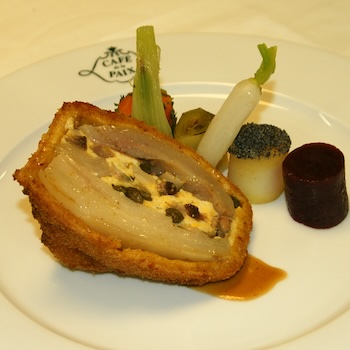Repellent to English-speaking people, calf’s head remains one of the most political and divisive dishes in French cuisine.It is also a symbol of popular, bistro-style cooking in a France that prides itself on its many calf’s‑head brotherhoods.However, a recent book by historian Pierre Michon should encourage people to tone down French chauvinism on the subject.For it was probably England that gave calf’s head its most powerful political symbolism…
Nearly a century and a half before King Louis XVI was guillotined in 1793, English Republicans had already made it a festive regicidal dish at a banquet held every 30 January to commemorate the beheading of Charles I of England in 1649.

The historian describes the aura of mystery and fascination that long surrounded this Calves’ Head Club.In France, some revolutionaries initially chose a pig’s head to celebrate the regicide of Louis XVI, no doubt as a way of not copying the English.But the fame of the Calves’ Head Club eventually inspired French revolutionary banquets, which adopted the habit of eating calf’s head every 21 January, the day of the French king’s death.The custom still survives in certain republican circles.
Before it became a symbol of regicide, calf’s head was, particularly in the eighteenth century, a refined dish associated with social prestige.It could be prepared in many ways—stuffed, breaded, with mushrooms, or “à la tortue”, a famous recipe that came from across the Channel.In 1830, King Charles X, who would be overthrown by a revolution a few weeks later, allowed tripe-sellers to sell it, whereas until then only butchers were permitted to do so.This decision triggered the democratization of the dish in France, and it would go on to become a bistro classic.
It was used to great effect by politicians such as former President Jacques Chirac in his rise to power.Since the 1980s, Pierre Michon notes, the French have gradually turned away from it, even though after 1945 it had become a symbol of quintessentially “Franco-French” cooking.But in the historian’s view, calf’s head has not yet had its last word!
Petite histoire de la tête de veau, ( A short history of calf’s head)
Pierre Michon
Editor Tallandier
Prix: 19,90€
Calf’s Head for 6 people
Preparation 30 minutes
Cooking 3 hours
(Source : Bistrotier, Stéphane Reynaud – Chêne editor)
1 rolled calf’s head
6 carrots
6 BF 15 potatoes
3 fennel bulbs
3 pak choi
1 bouquet garni
3 onions, 6 cloves
2 tbsp coarse salt
- Place the calf’s head in a saucepan, cover with plenty of water, add 1 tablespoon of coarse salt, bring to a boil for 5 minutes, then rinse. Return the calf’s head to a large pot of salted water, bring to a boil, add the bouquet garni and the onions studded with cloves, and simmer for 2 hours.
- Peel the carrots and potatoes, and halve the fennel and pak choi. Add the carrots to the head, cook for 3 to 4 minutes, then add all the other vegetables for another 30 minutes.
- In its bistro-style version, calf’s head is most often served either with a gribiche sauce or with a ravigote sauce. The first is prepared almost like a mayonnaise and includes two hard-boiled eggs; the second is made like a vinaigrette and contains no eggs. But there is a much more elaborate and flavourful recipe known as “à la tortue”, originally inspired by the turtle soups of the British West Indies.